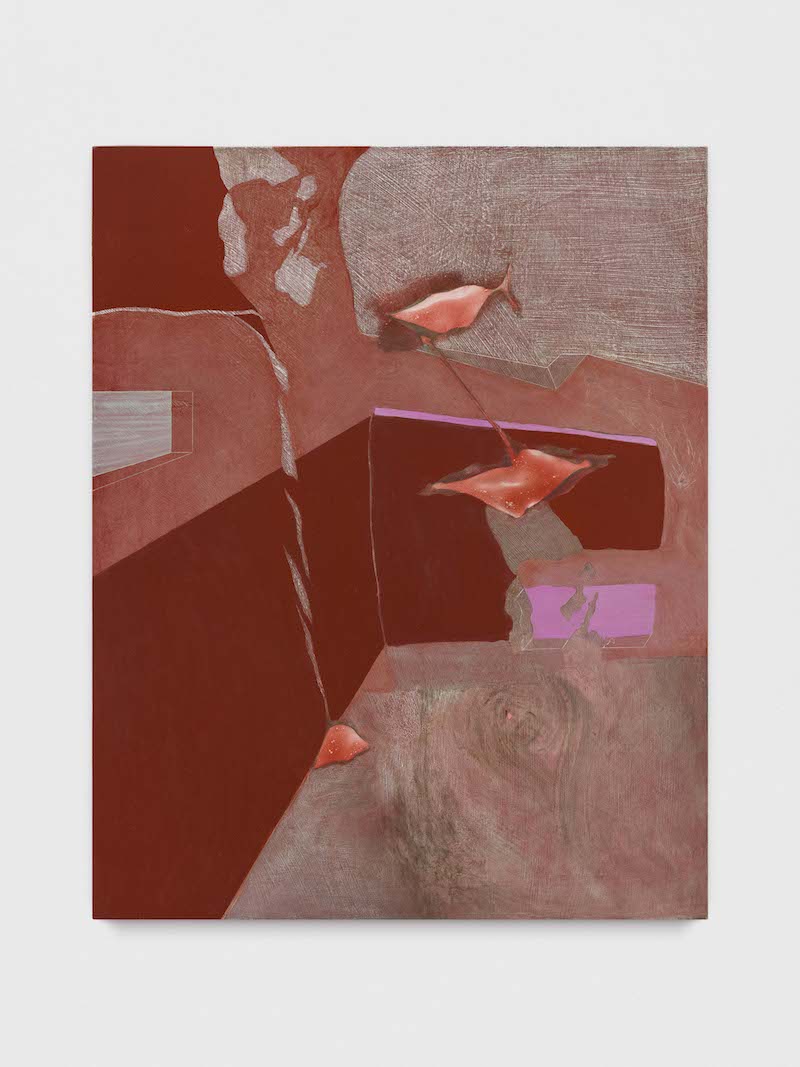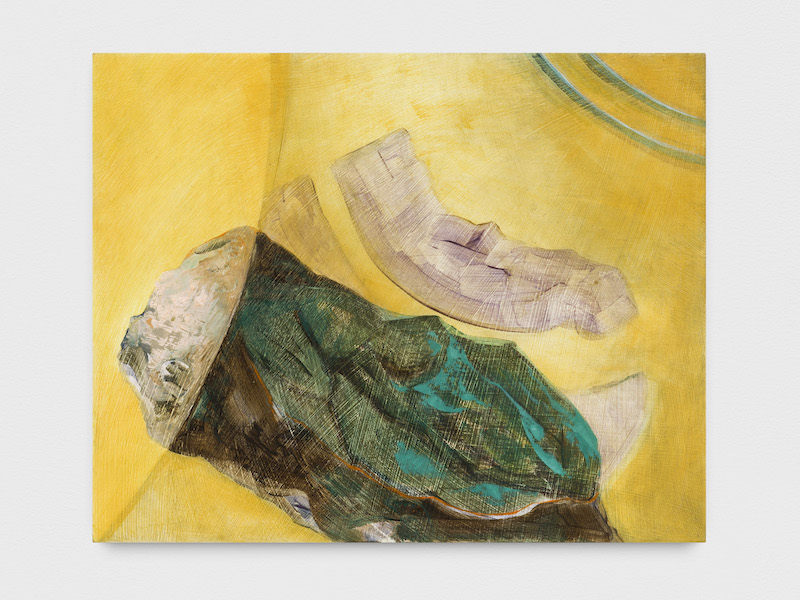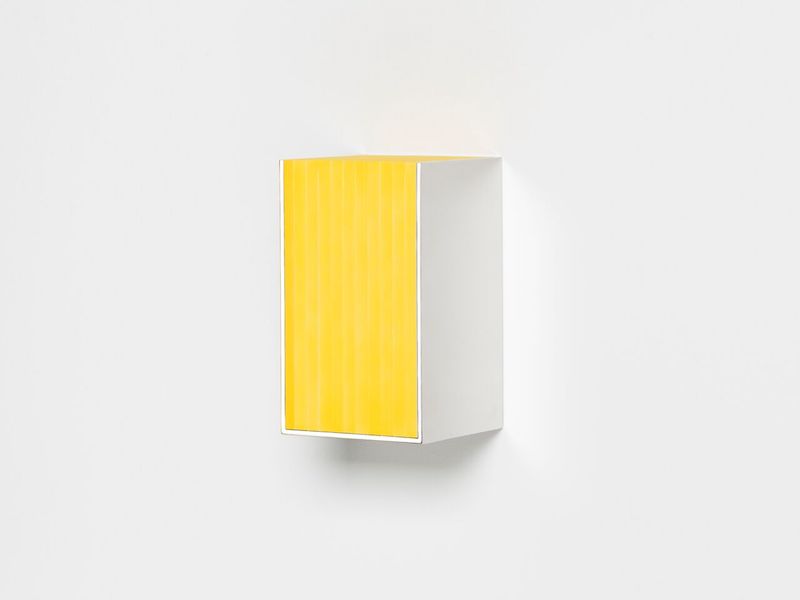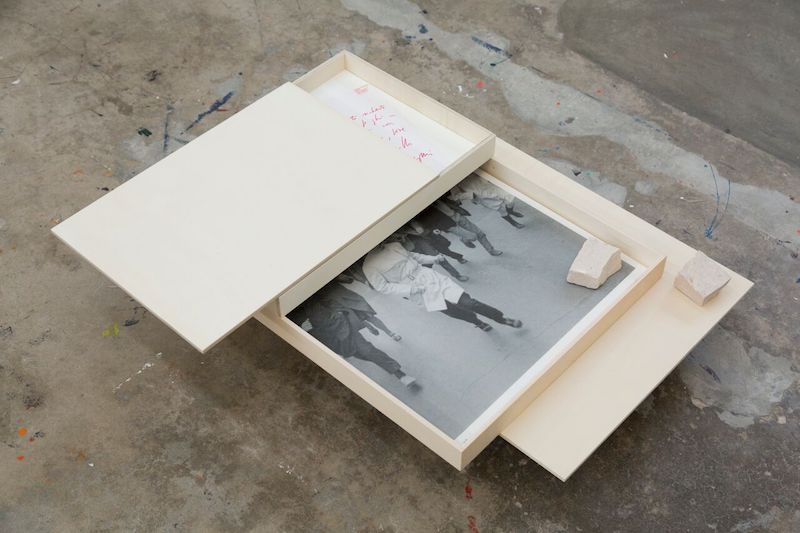On the rain-swept Saturday morning-after-the-night-before, I join the tight throngs of gallery visitors in the wide streets and parking lots of Potsdamer Straße. It is a different vibe from the Friday openings: less festive, more determined to see the art. I absorb this mentality, dragging a friend up and down the grey pavement and marching in and out of escalators. We arrive at the warren of galleries in Potsdamer Straße 77-87, and the walkabout begins.

Iulia Nistor: ‘Evidence E4 F9 P9’, 2016, oil on wood, 50 x 40 cm // Photo by Trevor Good, courtesy the artist and Plan B Cluj, Berlin
The precision and confident fragility of Iulia Nistor’s paintings at Plan B provide an immediate counterpoint to the blank facades of Potsdamer Straße. The exhibition program describes her pieces as attempts ‘to picture the faculties of sensation like mouth and ear’ and, indeed, Nistor seems to demand special access to a set of connective tissues and neuronal links that control our most basic functions. Her paintings insist on the materiality of processes that seem magical and intangible. They exhibit forms that trigger visceral, body-based descriptions: bloated, squashed; tubes, cocoons. Sometimes these quasi-organic shapes loom on a page of colour, sometimes they seem to be placed within architecture—a room, a funnel, a half-pipe—as though concretising the metaphor of body as house. As I walk around the eleven small paintings, I find myself buying into Nistor’s vision: why shouldn’t the processes of the body look like intricate designs revealed in a dream? There is something delightfully impersonal about her pieces. For her, ‘materialising’ human processes means ridding them of an ‘I’; psychoanalysis does not interest her. It is easy to overlook the bare concrete wall on one side of the exhibition space, but its inclusion is illuminating. What seems like the frame of a wall being exposed is in fact, according to the exhibition program, artifice. The concrete has been applied like paint, giving the illusion of something foundational and stripped down. Nistor is challenging our equation of truth with primordial bareness. She is insisting on what is painted, over what seems blank.

Iulia Nistor:’Evidence E7 W6 A3′, 2016, oil on wood, 40 x 50 cm // Photo by Trevor Good, courtesy the artist and Plan B Cluj, Berlin
Fernanda Fragateiro’s ‘DEMO’ is a discomfitingly ordered set of discrete pieces in the large open gallery space of Arratia Beer. What could be further from the rush and messy spontaneity of a protest than the clean, primarily rectangular shapes that dominate the show? And yet, this difficult juxtaposition seems to be Fragateiro’s aim. Meticulously designed books, with blank front covers and untouched pages, recur throughout the exhibition, some with specially-fitted stainless steel supports of no apparent functionality.

Fernanda Fragateiro: ‘Having words’, 2016, Polished stainless steel and books: Having Words, Denise ScottBrown, in Architecture Words, published by AA School and AAPublications, London, 18 x 11 x 10,5 cm // Photo by António Jorge Silva
It is the form of these books that we are drawn to; there is no hint as to their content. Another recurrent feature is large-format photographs of protests slipped behind files, shelves or books, so that they are partially obscured. The words that come to mind when viewing ‘DEMO’ are to do with presentation and attention: filing, binding, organising. The titles provide insight into the dilemma the artist is pinpointing: ‘Having words’ and ‘Tectonic Acts of Desire and Doubt’ are both tiny metal holders filled with decoratively-dyed pages, on which no words are visible. We are reminded that having words and strong feelings does not determine what we will do with them: how we will order them, how we will prioritise them. In a world overflowing with media, Fragateiro’s work reads as a self-aware attempt to keep on top of information, to bind it and own it and file it away. And yet, the dormant power of the tidied information and the hidden words speaks through the clean formalism of her design.

Fernanda Fragateiro: ‘Materials Lab (demo)’, 2017, Inkjet print from ‘Demo’, original letter by artist Arnaldo Pomodoro to art dealer Gloria Bustt, inkjet print of ‘Demo’ page 60, stone from Lisbon sidewalk pavement // Photo by António Jorge Silva
Galerie Guido W. Baudach presents its third solo show of Jürgen Klauke’s work, from the 70s until the present. The bold large-format photographs vibrate with the experimentation and determined shape-shifting of the renowned body artist. The early works have an intense playfulness: Klauke’s irreverence is charmingly offset by the intricacy and anatomical curiosity displayed by his costumes.
The tableaux are full of movement and immediacy: the gender play seems to happen before our eyes, giving us a real insight into the incremental stages of adopting a feminine, masculine or androgynous position for Klauke. The exhibition program does slightly overstep the mark when it suggests that Klauke works on gender difference ‘more emphatically and radically than anyone else’. I would not be alone in countering this statement by pointing at the contemporaneous work of women body artists like VALIE EXPORT and Ulrike Rosenbach in Germany and Austria alone, whose barriers to entry in the art world were arguably higher, as women. For fans of the feminist avant-garde of the 70s, Klauke’s early work will seem exciting and allied to the deconstructive and assertive aims of that cohort. His later work is more dramatic and even cinematic in its focused intensity, without losing the tongue-in-cheek quality that tests our reception, and makes us wonder about the seriousness of this unmistakeably important work.
Exhibition Info
PLAN B
Iulia Nistor: ‘canary in a coal mine’
Exhibition: Apr. 28 – Jun. 17, 2017
Potsdamer Strasse 77–87, 10785 Berlin, click here for map
ARRATIA BEER
Fernanda Fragateiro: ‘DEMO’
Exhibition: Apr. 28 – Jun. 10, 2017
Potsdamer Strasse 77–87, 10785 Berlin, click here for map
GUIDO W BAUDACH
Jürgen Klauke: ‘Bewegtes Ich’
Exhibition: Apr. 28 – Jun. 10, 2017
Potsdamer Straße 85, 10785 Berlin, click here for map


























